-
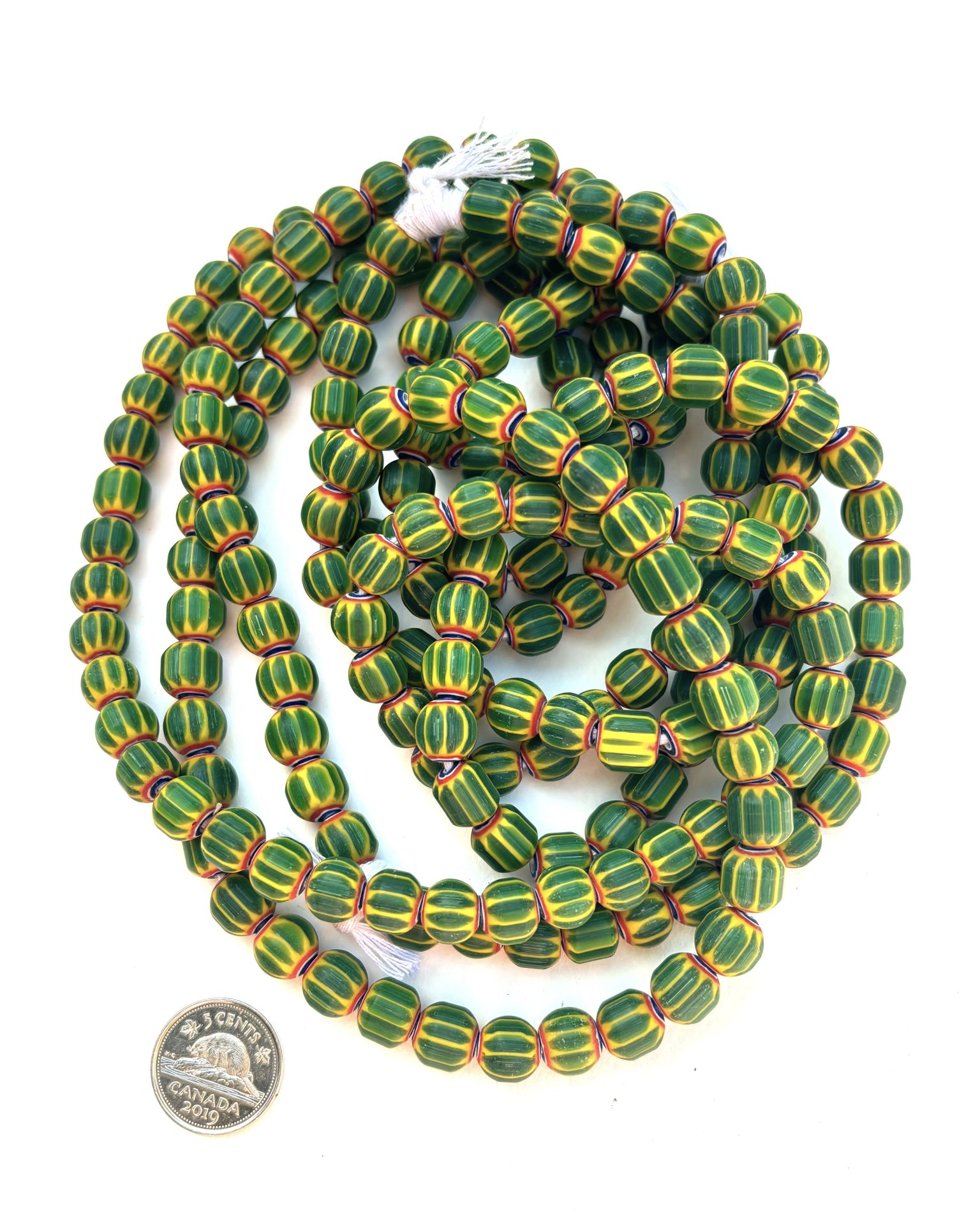
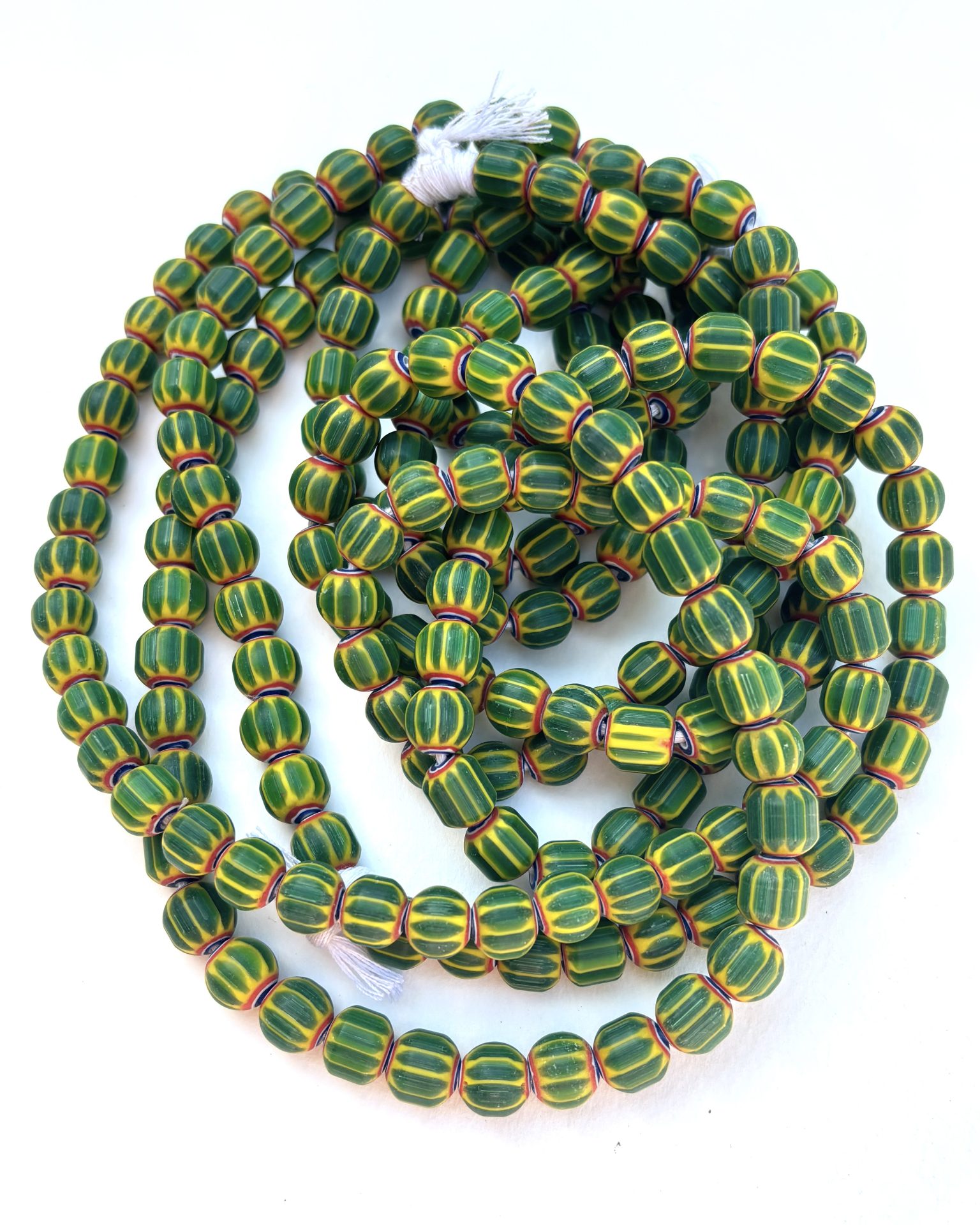 About 75 Contemporary Glass Chevron Beads were probably made in India and traded in Ghana W. Africa. Found some of these in the largest Bead Market in W. Africa and since they are very popular decided to get more in more colours and shapes! Each green, yellow and a touch of red bead is about 10 mm. The beads vary in size, shape and colour. You will receive one of the strands in the image.
About 75 Contemporary Glass Chevron Beads were probably made in India and traded in Ghana W. Africa. Found some of these in the largest Bead Market in W. Africa and since they are very popular decided to get more in more colours and shapes! Each green, yellow and a touch of red bead is about 10 mm. The beads vary in size, shape and colour. You will receive one of the strands in the image. -
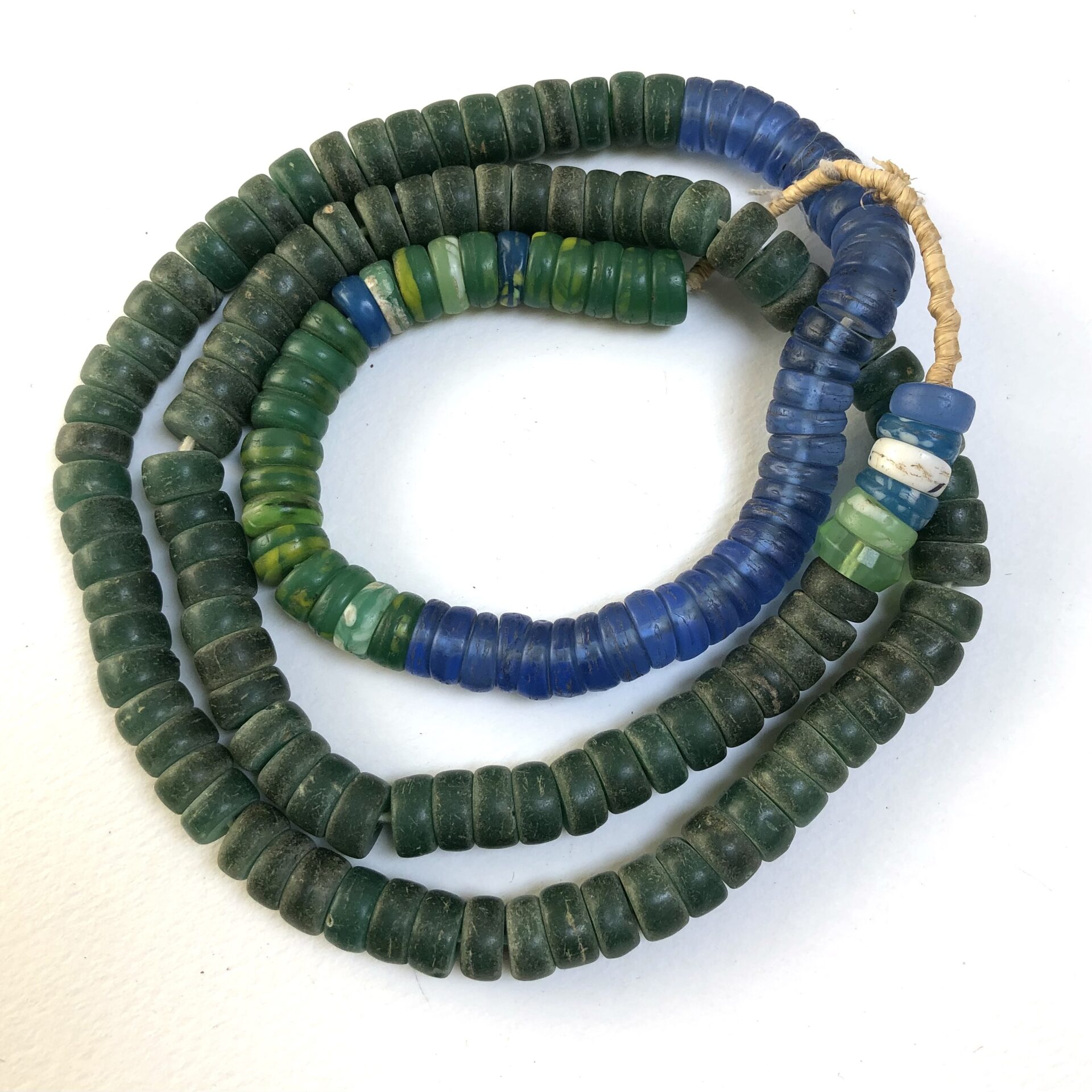
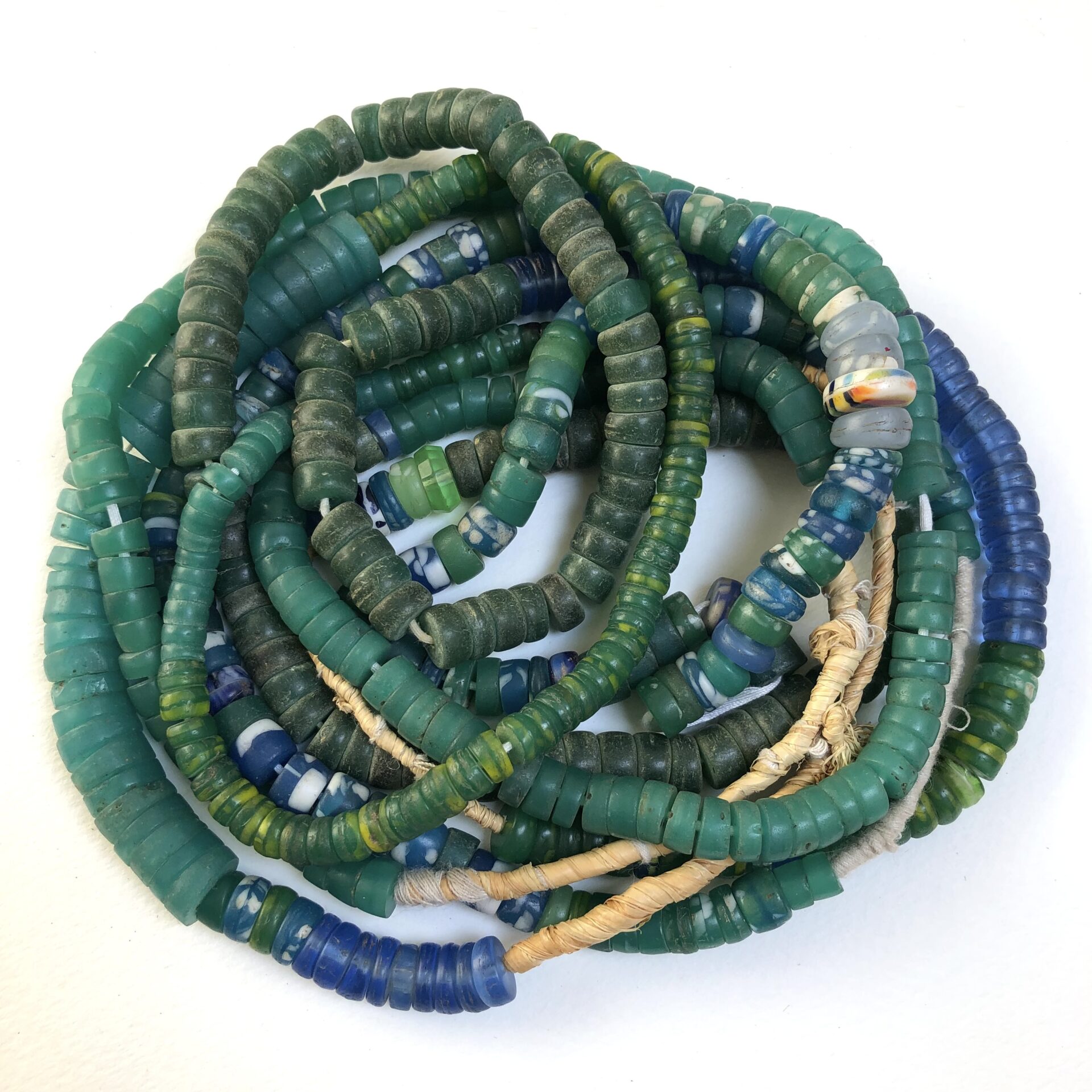 There are 4 strands of Kakamba Prosser for you to choose from. These are great spacer beads. Prosser beads are by extension any beads made by the 'Prosser' technique, invented by the Prosser brothers in 1840 in England for the purpose of making buttons. The process consists of molding a cold paste under great pressure and then firing it. Prosser Beads were distinct from other European trade beads in that they were produced in a great variety of colors, and were also translucent. They were received particularly well in the town of Kakamba in the Republic of the Congo – hence the name Kakamba Prosser Beads.
There are 4 strands of Kakamba Prosser for you to choose from. These are great spacer beads. Prosser beads are by extension any beads made by the 'Prosser' technique, invented by the Prosser brothers in 1840 in England for the purpose of making buttons. The process consists of molding a cold paste under great pressure and then firing it. Prosser Beads were distinct from other European trade beads in that they were produced in a great variety of colors, and were also translucent. They were received particularly well in the town of Kakamba in the Republic of the Congo – hence the name Kakamba Prosser Beads. -
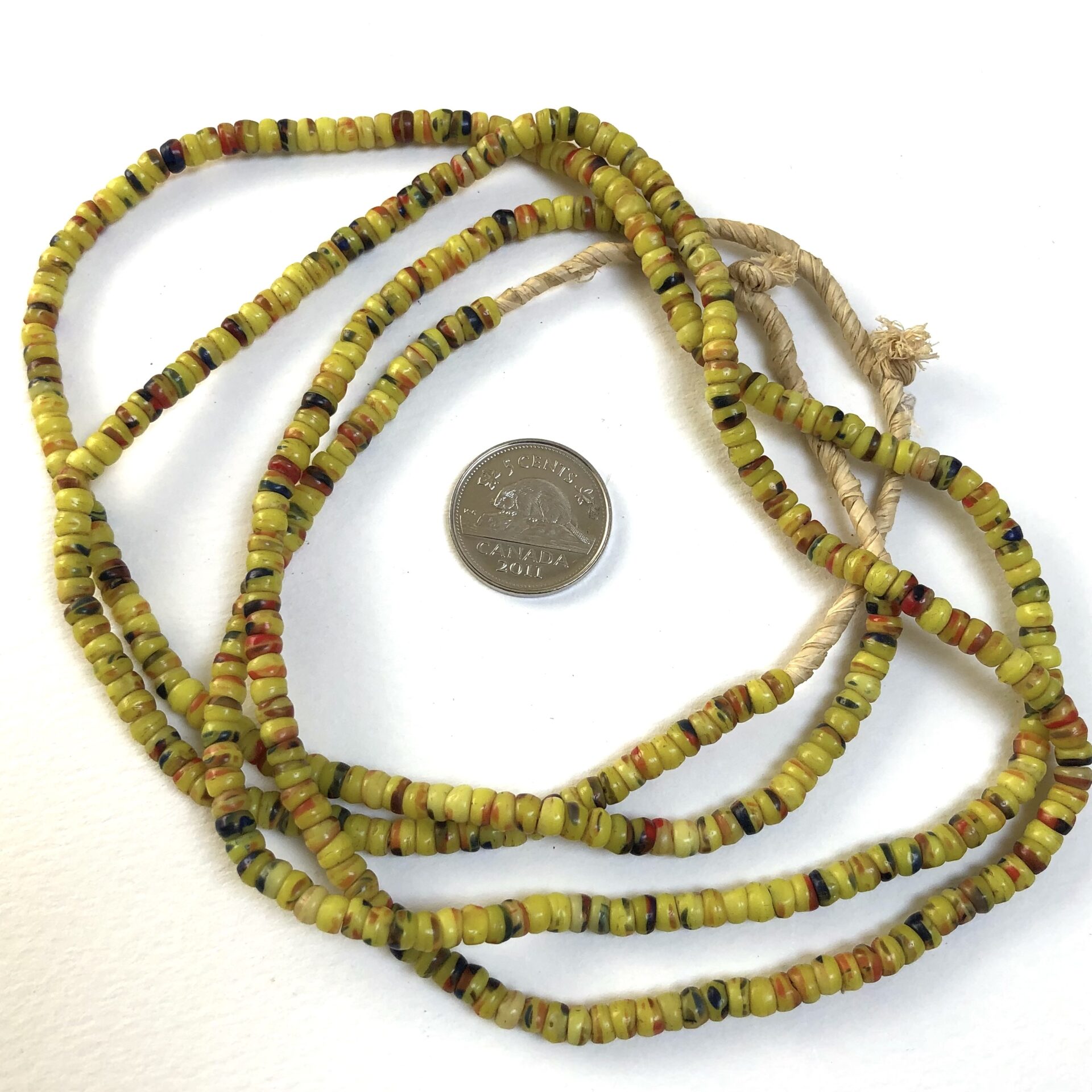
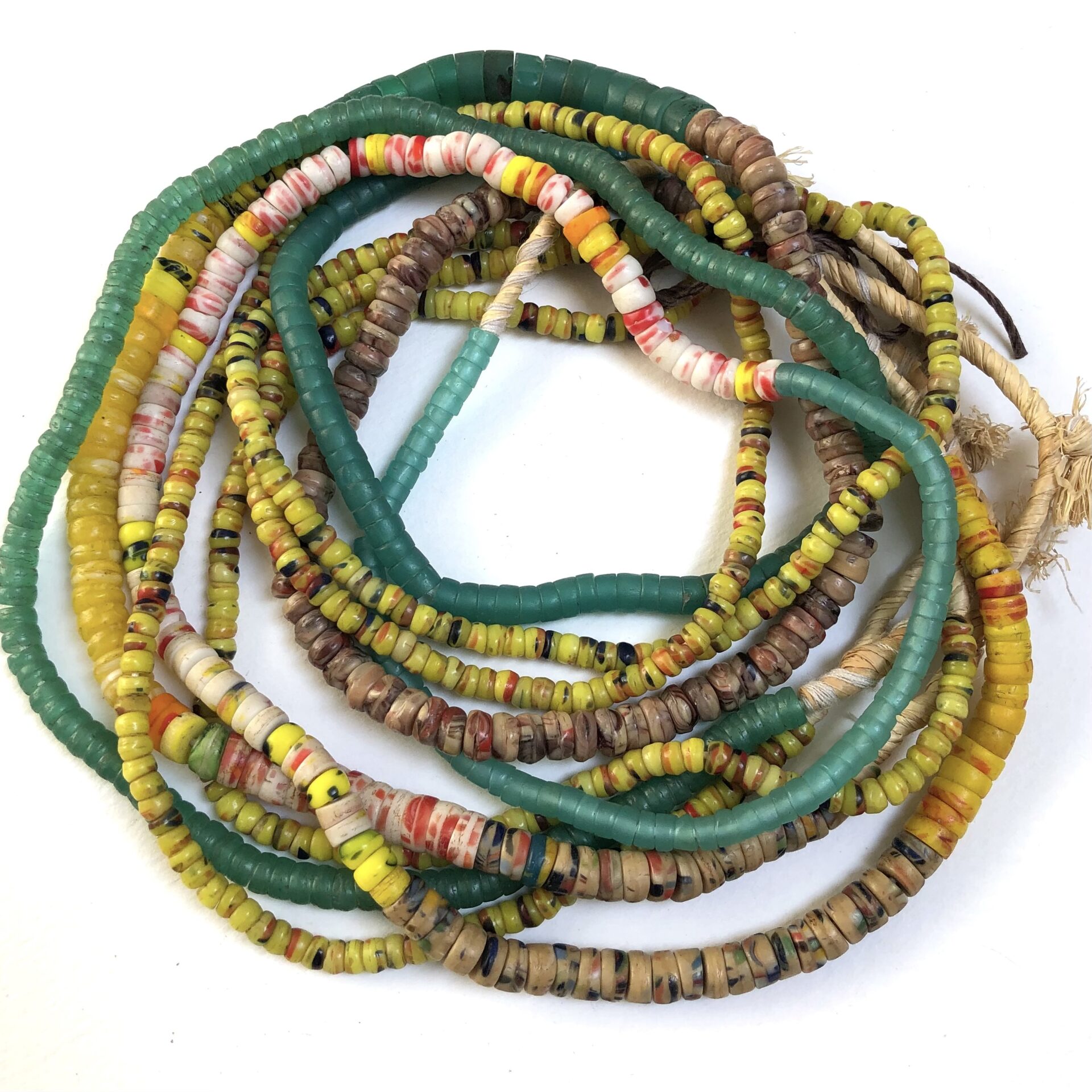 A strand of Kakamba Prosser Beads about 24" long. There are 4 strands for you to choose from. These are great spacer beads. Prosser beads are by extension any beads made by the 'Prosser' technique, invented by the Prosser brothers in 1840 in England for the purpose of making buttons. The process consists of molding a cold paste under great pressure and then firing it. Prosser Beads were distinct from other European trade beads in that they were produced in a great variety of colors, and were also translucent. They were received particularly well in the town of Kakamba in the Republic of the Congo – hence the name Kakamba Prosser Beads.
A strand of Kakamba Prosser Beads about 24" long. There are 4 strands for you to choose from. These are great spacer beads. Prosser beads are by extension any beads made by the 'Prosser' technique, invented by the Prosser brothers in 1840 in England for the purpose of making buttons. The process consists of molding a cold paste under great pressure and then firing it. Prosser Beads were distinct from other European trade beads in that they were produced in a great variety of colors, and were also translucent. They were received particularly well in the town of Kakamba in the Republic of the Congo – hence the name Kakamba Prosser Beads. -
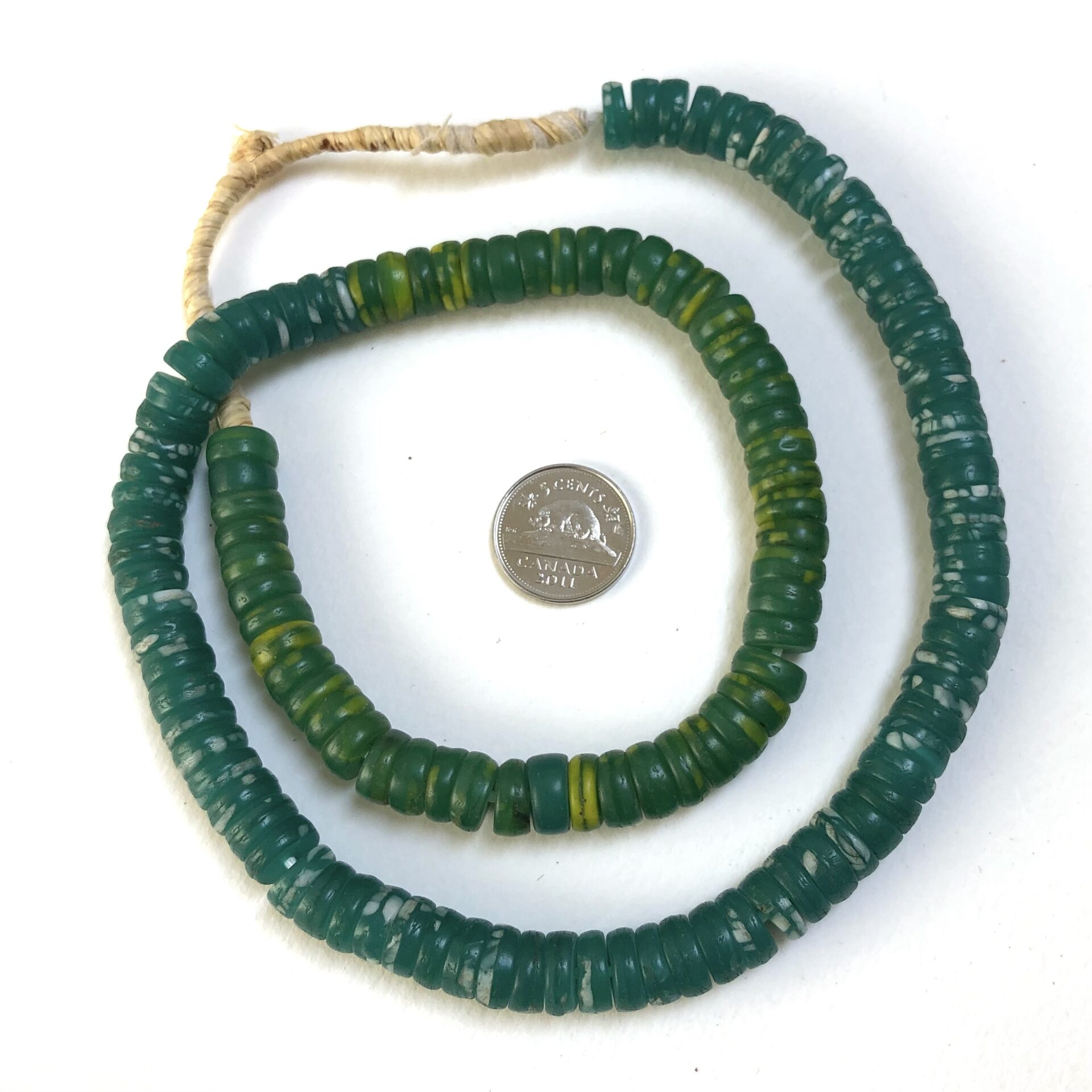
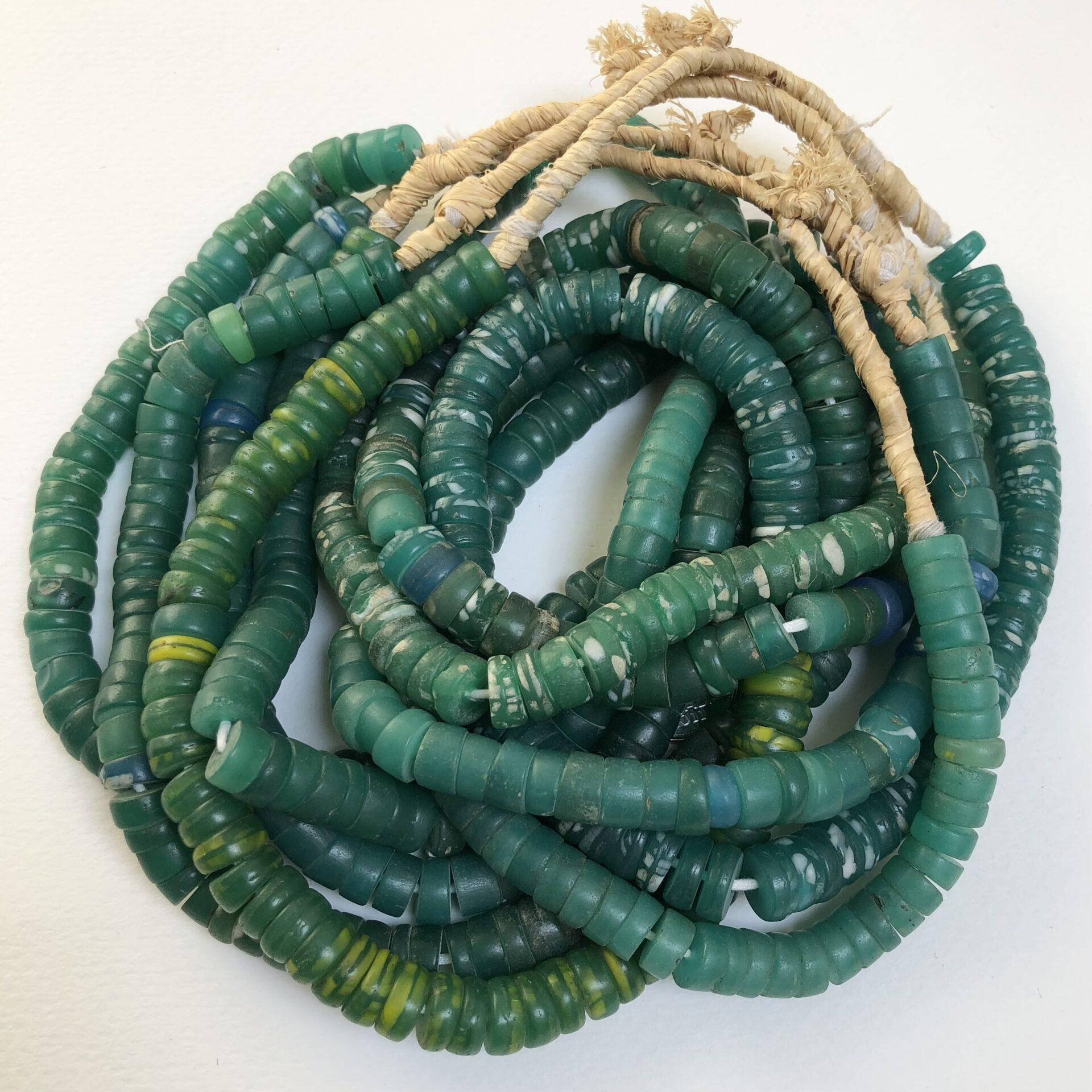 A strand of Kakamba Prosser Beads about 24" long. There are 5 strands for you to choose from. These are great spacer beads. Prosser beads are by extension any beads made by the 'Prosser' technique, invented by the Prosser brothers in 1840 in England for the purpose of making buttons. The process consists of molding a cold paste under great pressure and then firing it. Prosser Beads were distinct from other European trade beads in that they were produced in a great variety of colors, and were also translucent. They were received particularly well in the town of Kakamba in the Republic of the Congo – hence the name Kakamba Prosser Beads.
A strand of Kakamba Prosser Beads about 24" long. There are 5 strands for you to choose from. These are great spacer beads. Prosser beads are by extension any beads made by the 'Prosser' technique, invented by the Prosser brothers in 1840 in England for the purpose of making buttons. The process consists of molding a cold paste under great pressure and then firing it. Prosser Beads were distinct from other European trade beads in that they were produced in a great variety of colors, and were also translucent. They were received particularly well in the town of Kakamba in the Republic of the Congo – hence the name Kakamba Prosser Beads. -
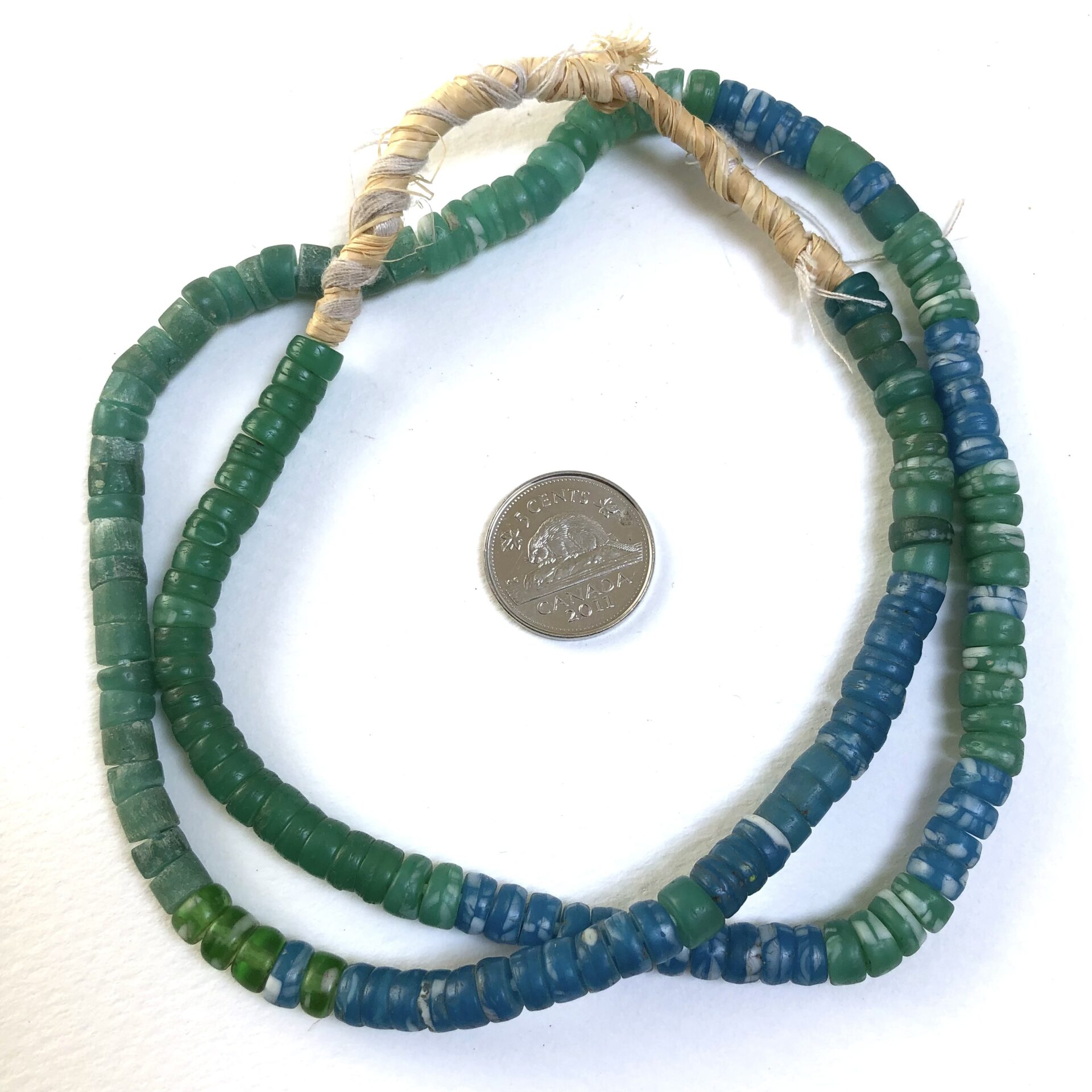
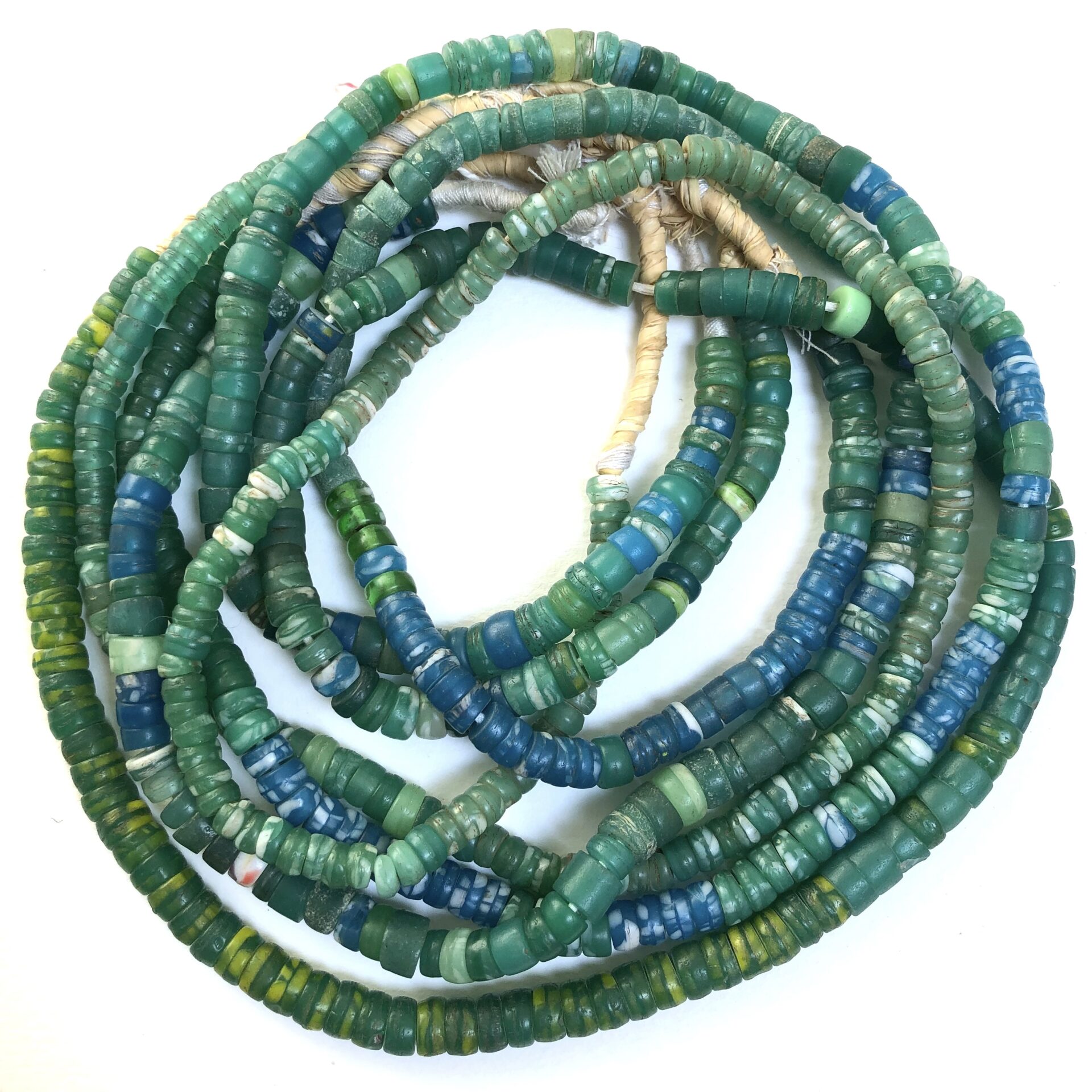 A strand of Kakamba Prosser Beads about 24" long. There are 4 strands for you to choose from. These are great spacer beads. Prosser beads are by extension any beads made by the 'Prosser' technique, invented by the Prosser brothers in 1840 in England for the purpose of making buttons. The process consists of molding a cold paste under great pressure and then firing it. Prosser Beads were distinct from other European trade beads in that they were produced in a great variety of colors, and were also translucent. They were received particularly well in the town of Kakamba in the Republic of the Congo – hence the name Kakamba Prosser Beads.
A strand of Kakamba Prosser Beads about 24" long. There are 4 strands for you to choose from. These are great spacer beads. Prosser beads are by extension any beads made by the 'Prosser' technique, invented by the Prosser brothers in 1840 in England for the purpose of making buttons. The process consists of molding a cold paste under great pressure and then firing it. Prosser Beads were distinct from other European trade beads in that they were produced in a great variety of colors, and were also translucent. They were received particularly well in the town of Kakamba in the Republic of the Congo – hence the name Kakamba Prosser Beads. -

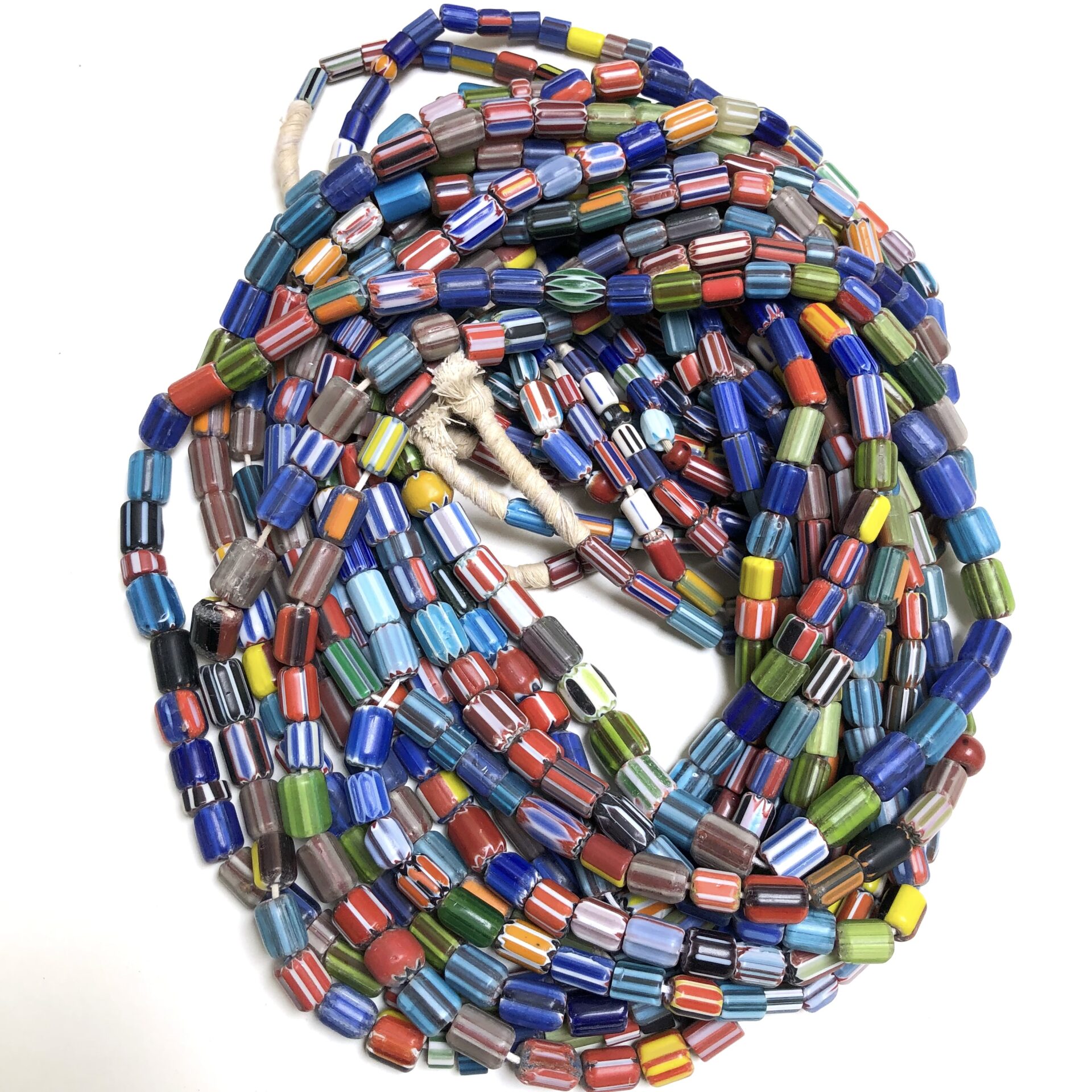 A strand of assorted Chevron Beads on string 34" long. The beads vary in size, colour and shape. ' Venetian chevron beads have been traded throughout the world, most heavily in West Africa, where they were first introduced by Dutch merchants in the late 15th century. ' (wikipedia) You will receive a strand similar to the ones in the photo. .55/bead ... if you would like only several beads please contact us ...
A strand of assorted Chevron Beads on string 34" long. The beads vary in size, colour and shape. ' Venetian chevron beads have been traded throughout the world, most heavily in West Africa, where they were first introduced by Dutch merchants in the late 15th century. ' (wikipedia) You will receive a strand similar to the ones in the photo. .55/bead ... if you would like only several beads please contact us ... -

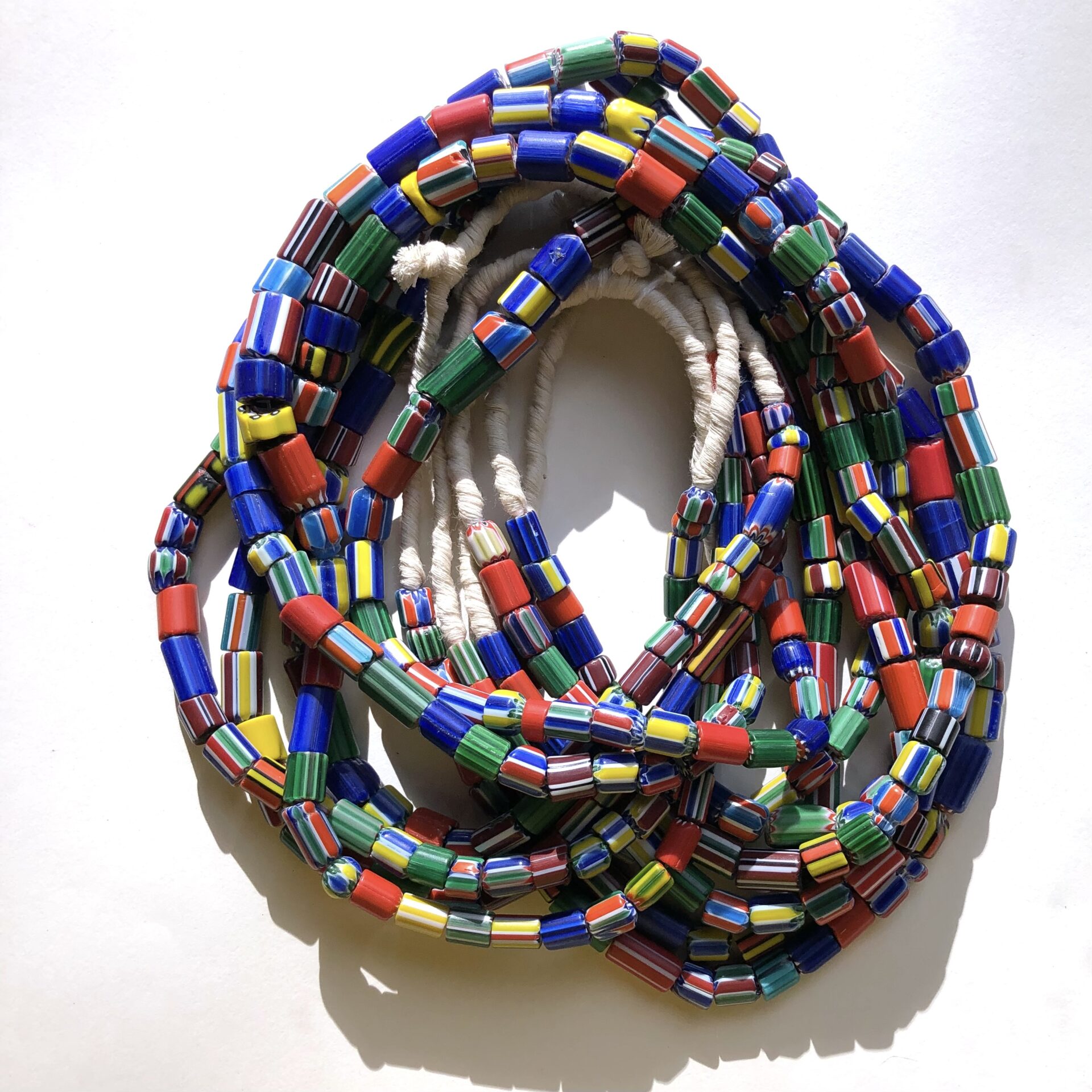 A strand of assorted Chevron Beads on fishing line 30" long. The beads vary in size, colour and shape. ' Venetian chevron beads have been traded throughout the world, most heavily in West Africa, where they were first introduced by Dutch merchants in the late 15th century. ' (wikipedia) You will receive a strand similar to one in the photo.
A strand of assorted Chevron Beads on fishing line 30" long. The beads vary in size, colour and shape. ' Venetian chevron beads have been traded throughout the world, most heavily in West Africa, where they were first introduced by Dutch merchants in the late 15th century. ' (wikipedia) You will receive a strand similar to one in the photo. -
Out of stock

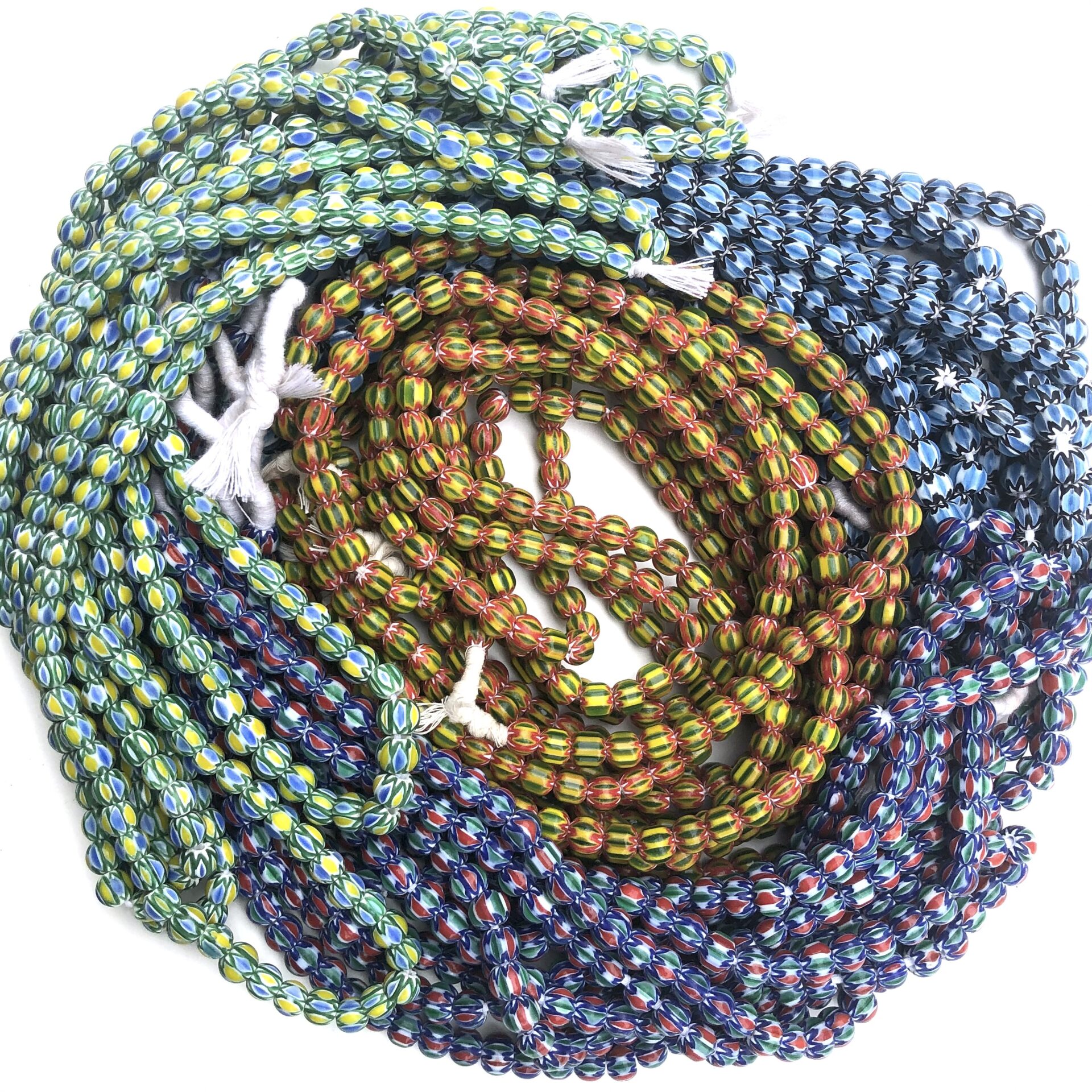 Contemporary Glass Chevron Beads were probably made in India and traded in Ghana W. Africa. Found some of these in the largest Bead Market in W. Africa and since they are very popular decided to get more in more colours and shapes! Each bead is about 6 mm in diameter. There are 4 colour variations to choose from. The beads vary in size, shape and colour. You will receive a strand similar to the one in the image. 12 Yellow, Green and Blue Chevrons for $2 are available here. 12 Navy, Red and Green Chevrons for $2 are available here.
Contemporary Glass Chevron Beads were probably made in India and traded in Ghana W. Africa. Found some of these in the largest Bead Market in W. Africa and since they are very popular decided to get more in more colours and shapes! Each bead is about 6 mm in diameter. There are 4 colour variations to choose from. The beads vary in size, shape and colour. You will receive a strand similar to the one in the image. 12 Yellow, Green and Blue Chevrons for $2 are available here. 12 Navy, Red and Green Chevrons for $2 are available here. -

 12 contemporary glass Chevron Beads in black, lime with touches of red. These beads were probably made in India and traded in Ghana W. Africa. I found these beads in one of the largest beads markets, Koforidua Bead Market. Each bead is about 6 mm in diameter. These are the only beads available in this colour. You can buy strands of other colours here.
12 contemporary glass Chevron Beads in black, lime with touches of red. These beads were probably made in India and traded in Ghana W. Africa. I found these beads in one of the largest beads markets, Koforidua Bead Market. Each bead is about 6 mm in diameter. These are the only beads available in this colour. You can buy strands of other colours here. -

 12 contemporary glass Chevron Beads in blue, green and red. These beads were probably made in India and traded in Ghana W. Africa. I found these beads in one of the largest beads markets, Koforidua Bead Market. Each bead is about 6 mm in diameter. The beads vary in size, shape and colour. You can buy a whole strand of this Chevron Bead here.
12 contemporary glass Chevron Beads in blue, green and red. These beads were probably made in India and traded in Ghana W. Africa. I found these beads in one of the largest beads markets, Koforidua Bead Market. Each bead is about 6 mm in diameter. The beads vary in size, shape and colour. You can buy a whole strand of this Chevron Bead here. -
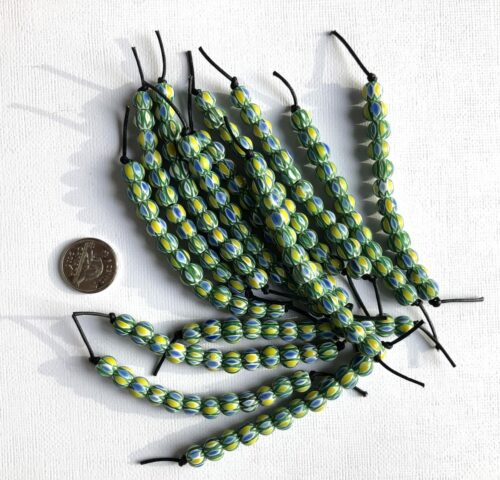
 12 contemporary glass Chevron Beads in white, green and lime with touches of blue. These beads were probably made in India and traded in Ghana W. Africa. I found these beads in one of the largest beads markets, Koforidua Bead Market. Each bead is about 8 mm in diameter. These chevrons are available in strands here.
12 contemporary glass Chevron Beads in white, green and lime with touches of blue. These beads were probably made in India and traded in Ghana W. Africa. I found these beads in one of the largest beads markets, Koforidua Bead Market. Each bead is about 8 mm in diameter. These chevrons are available in strands here. -
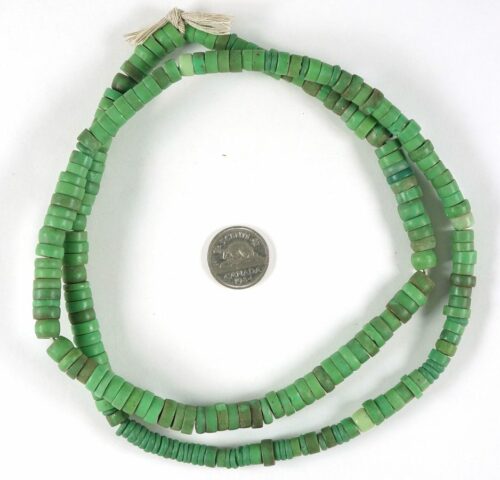
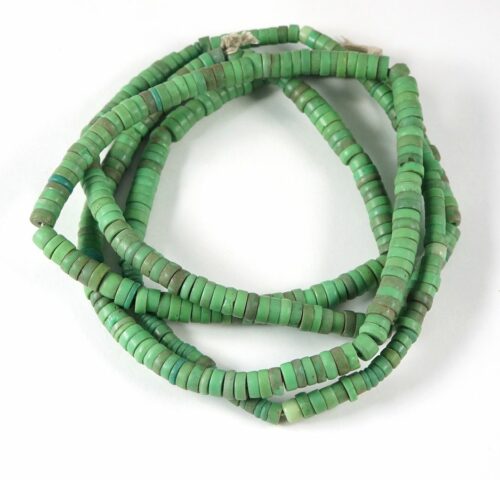 A strand of green button-like Prosser Beads on string 30" long. The beads are varying sizes, around 5 mm to 7 mm. Hole opening around .5 mm. These are great spacer beads. You will received the image with the penny. Prosser beads are by extension any beads made by the 'Prosser' technique, invented by the Prosser brothers in 1840 in England for the purpose of making buttons. The process consists of molding a cold paste under great pressure and then firing it.
A strand of green button-like Prosser Beads on string 30" long. The beads are varying sizes, around 5 mm to 7 mm. Hole opening around .5 mm. These are great spacer beads. You will received the image with the penny. Prosser beads are by extension any beads made by the 'Prosser' technique, invented by the Prosser brothers in 1840 in England for the purpose of making buttons. The process consists of molding a cold paste under great pressure and then firing it. -

 A strand of 175 small green button-like Prosser Beads on raffia 26" long. Each bead is about 7 mm in diameter. These are great spacer beads. Prosser beads are by extension any beads made by the 'Prosser' technique, invented by the Prosser brothers in 1840 in England for the purpose of making buttons. The process consists of molding a cold paste under great pressure and then firing it.
A strand of 175 small green button-like Prosser Beads on raffia 26" long. Each bead is about 7 mm in diameter. These are great spacer beads. Prosser beads are by extension any beads made by the 'Prosser' technique, invented by the Prosser brothers in 1840 in England for the purpose of making buttons. The process consists of molding a cold paste under great pressure and then firing it. -

 A strand of Kakamba Prosser Beads about 23" long. The glass beads are about 5 mm in diameter. These are great spacer beads. An assortment of colours. You will receive a strand similar to the strands shown. There are variations between strands. Prosser beads are by extension any beads made by the 'Prosser' technique, invented by the Prosser brothers in 1840 in England for the purpose of making buttons. The process consists of molding a cold paste under great pressure and then firing it. Prosser Beads were distinct from other European trade beads in that they were produced in a great variety of colors, and were also translucent. They were received particularly well in the town of Kakamba in the Republic of the Congo – hence the name Kakamba Prosser Beads.
A strand of Kakamba Prosser Beads about 23" long. The glass beads are about 5 mm in diameter. These are great spacer beads. An assortment of colours. You will receive a strand similar to the strands shown. There are variations between strands. Prosser beads are by extension any beads made by the 'Prosser' technique, invented by the Prosser brothers in 1840 in England for the purpose of making buttons. The process consists of molding a cold paste under great pressure and then firing it. Prosser Beads were distinct from other European trade beads in that they were produced in a great variety of colors, and were also translucent. They were received particularly well in the town of Kakamba in the Republic of the Congo – hence the name Kakamba Prosser Beads. -

 A strand of over 150 Kakamba Prosser Beads about 32" long. There are two different strands to choose from. These are great spacer beads. The bead is a shade of translucent green. Prosser beads are by extension any beads made by the 'Prosser' technique, invented by the Prosser brothers in 1840 in England for the purpose of making buttons. The process consists of molding a cold paste under great pressure and then firing it. Prosser Beads were distinct from other European trade beads in that they were produced in a great variety of colors, and were also translucent. They were received particularly well in the town of Kakamba in the Republic of the Congo – hence the name Kakamba Prosser Beads.
A strand of over 150 Kakamba Prosser Beads about 32" long. There are two different strands to choose from. These are great spacer beads. The bead is a shade of translucent green. Prosser beads are by extension any beads made by the 'Prosser' technique, invented by the Prosser brothers in 1840 in England for the purpose of making buttons. The process consists of molding a cold paste under great pressure and then firing it. Prosser Beads were distinct from other European trade beads in that they were produced in a great variety of colors, and were also translucent. They were received particularly well in the town of Kakamba in the Republic of the Congo – hence the name Kakamba Prosser Beads. -

 A strand of over 125 Kakamba Prosser Beads about 31" long. The beads are about 12 mm in diameter. These are great spacer beads.The beads are a translucent light green. You will get one or other of the strands shown. Prosser beads are by extension any beads made by the 'Prosser' technique, invented by the Prosser brothers in 1840 in England for the purpose of making buttons. The process consists of molding a cold paste under great pressure and then firing it. Prosser Beads were distinct from other European trade beads in that they were produced in a great variety of colors, and were also translucent. They were received particularly well in the town of Kakamba in the Republic of the Congo – hence the name Kakamba Prosser Beads.
A strand of over 125 Kakamba Prosser Beads about 31" long. The beads are about 12 mm in diameter. These are great spacer beads.The beads are a translucent light green. You will get one or other of the strands shown. Prosser beads are by extension any beads made by the 'Prosser' technique, invented by the Prosser brothers in 1840 in England for the purpose of making buttons. The process consists of molding a cold paste under great pressure and then firing it. Prosser Beads were distinct from other European trade beads in that they were produced in a great variety of colors, and were also translucent. They were received particularly well in the town of Kakamba in the Republic of the Congo – hence the name Kakamba Prosser Beads. -

 A strand of Kakamba Prosser Beads about 30" long. The beads are about 7-8 mm in diameter. These are great spacer beads.The beads are a translucent various shade of green. You will get the strand shown. Prosser beads are by extension any beads made by the 'Prosser' technique, invented by the Prosser brothers in 1840 in England for the purpose of making buttons. The process consists of molding a cold paste under great pressure and then firing it. Prosser Beads were distinct from other European trade beads in that they were produced in a great variety of colors, and were also translucent. They were received particularly well in the town of Kakamba in the Republic of the Congo – hence the name Kakamba Prosser Beads.
A strand of Kakamba Prosser Beads about 30" long. The beads are about 7-8 mm in diameter. These are great spacer beads.The beads are a translucent various shade of green. You will get the strand shown. Prosser beads are by extension any beads made by the 'Prosser' technique, invented by the Prosser brothers in 1840 in England for the purpose of making buttons. The process consists of molding a cold paste under great pressure and then firing it. Prosser Beads were distinct from other European trade beads in that they were produced in a great variety of colors, and were also translucent. They were received particularly well in the town of Kakamba in the Republic of the Congo – hence the name Kakamba Prosser Beads. -
 A strand of Kakamba Prosser Beads about 32" long. The beads are about 8 mm in diameter. These are great spacer beads.The beads are a gorgeous translucent light green. There are two strands very similar to choose from. Prosser beads are by extension any beads made by the 'Prosser' technique, invented by the Prosser brothers in 1840 in England for the purpose of making buttons. The process consists of molding a cold paste under great pressure and then firing it. Prosser Beads were distinct from other European trade beads in that they were produced in a great variety of colors, and were also translucent. They were received particularly well in the town of Kakamba in the Republic of the Congo – hence the name Kakamba Prosser Beads.
A strand of Kakamba Prosser Beads about 32" long. The beads are about 8 mm in diameter. These are great spacer beads.The beads are a gorgeous translucent light green. There are two strands very similar to choose from. Prosser beads are by extension any beads made by the 'Prosser' technique, invented by the Prosser brothers in 1840 in England for the purpose of making buttons. The process consists of molding a cold paste under great pressure and then firing it. Prosser Beads were distinct from other European trade beads in that they were produced in a great variety of colors, and were also translucent. They were received particularly well in the town of Kakamba in the Republic of the Congo – hence the name Kakamba Prosser Beads. -

 A strand of Kakamba Prosser Beads about 22" long. The glass beads are about 6-12 mm in diameter. These are great spacer beads. You will receive the strand displayed. Prosser beads are by extension any beads made by the 'Prosser' technique, invented by the Prosser brothers in 1840 in England for the purpose of making buttons. The process consists of molding a cold paste under great pressure and then firing it. Prosser Beads were distinct from other European trade beads in that they were produced in a great variety of colors, and were also translucent. They were received particularly well in the town of Kakamba in the Republic of the Congo – hence the name Kakamba Prosser Beads.
A strand of Kakamba Prosser Beads about 22" long. The glass beads are about 6-12 mm in diameter. These are great spacer beads. You will receive the strand displayed. Prosser beads are by extension any beads made by the 'Prosser' technique, invented by the Prosser brothers in 1840 in England for the purpose of making buttons. The process consists of molding a cold paste under great pressure and then firing it. Prosser Beads were distinct from other European trade beads in that they were produced in a great variety of colors, and were also translucent. They were received particularly well in the town of Kakamba in the Republic of the Congo – hence the name Kakamba Prosser Beads. -

 A strand of Kakamba Prosser Beads about 30" long. The glass beads are about 6-9 mm in diameter. These are great spacer beads. You will receive the strand displayed. Prosser beads are by extension any beads made by the 'Prosser' technique, invented by the Prosser brothers in 1840 in England for the purpose of making buttons. The process consists of molding a cold paste under great pressure and then firing it. Prosser Beads were distinct from other European trade beads in that they were produced in a great variety of colors, and were also translucent. They were received particularly well in the town of Kakamba in the Republic of the Congo – hence the name Kakamba Prosser Beads.
A strand of Kakamba Prosser Beads about 30" long. The glass beads are about 6-9 mm in diameter. These are great spacer beads. You will receive the strand displayed. Prosser beads are by extension any beads made by the 'Prosser' technique, invented by the Prosser brothers in 1840 in England for the purpose of making buttons. The process consists of molding a cold paste under great pressure and then firing it. Prosser Beads were distinct from other European trade beads in that they were produced in a great variety of colors, and were also translucent. They were received particularly well in the town of Kakamba in the Republic of the Congo – hence the name Kakamba Prosser Beads. -

 A strand of Kakamba Prosser Beads about 30" long. The glass beads are about 7 mm in diameter. These are great spacer beads. You will receive one of the strands displayed. Prosser beads are by extension any beads made by the 'Prosser' technique, invented by the Prosser brothers in 1840 in England for the purpose of making buttons. The process consists of molding a cold paste under great pressure and then firing it. Prosser Beads were distinct from other European trade beads in that they were produced in a great variety of colors, and were also translucent. They were received particularly well in the town of Kakamba in the Republic of the Congo – hence the name Kakamba Prosser Beads.
A strand of Kakamba Prosser Beads about 30" long. The glass beads are about 7 mm in diameter. These are great spacer beads. You will receive one of the strands displayed. Prosser beads are by extension any beads made by the 'Prosser' technique, invented by the Prosser brothers in 1840 in England for the purpose of making buttons. The process consists of molding a cold paste under great pressure and then firing it. Prosser Beads were distinct from other European trade beads in that they were produced in a great variety of colors, and were also translucent. They were received particularly well in the town of Kakamba in the Republic of the Congo – hence the name Kakamba Prosser Beads. -

 A strand of Kakamba Prosser Beads about 32" long. The glass beads are about 9 mm in diameter. These are great spacer beads. You will receive the strand displayed with the penny. Prosser beads are by extension any beads made by the 'Prosser' technique, invented by the Prosser brothers in 1840 in England for the purpose of making buttons. The process consists of molding a cold paste under great pressure and then firing it. Prosser Beads were distinct from other European trade beads in that they were produced in a great variety of colors, and were also translucent. They were received particularly well in the town of Kakamba in the Republic of the Congo – hence the name Kakamba Prosser Beads.
A strand of Kakamba Prosser Beads about 32" long. The glass beads are about 9 mm in diameter. These are great spacer beads. You will receive the strand displayed with the penny. Prosser beads are by extension any beads made by the 'Prosser' technique, invented by the Prosser brothers in 1840 in England for the purpose of making buttons. The process consists of molding a cold paste under great pressure and then firing it. Prosser Beads were distinct from other European trade beads in that they were produced in a great variety of colors, and were also translucent. They were received particularly well in the town of Kakamba in the Republic of the Congo – hence the name Kakamba Prosser Beads.




